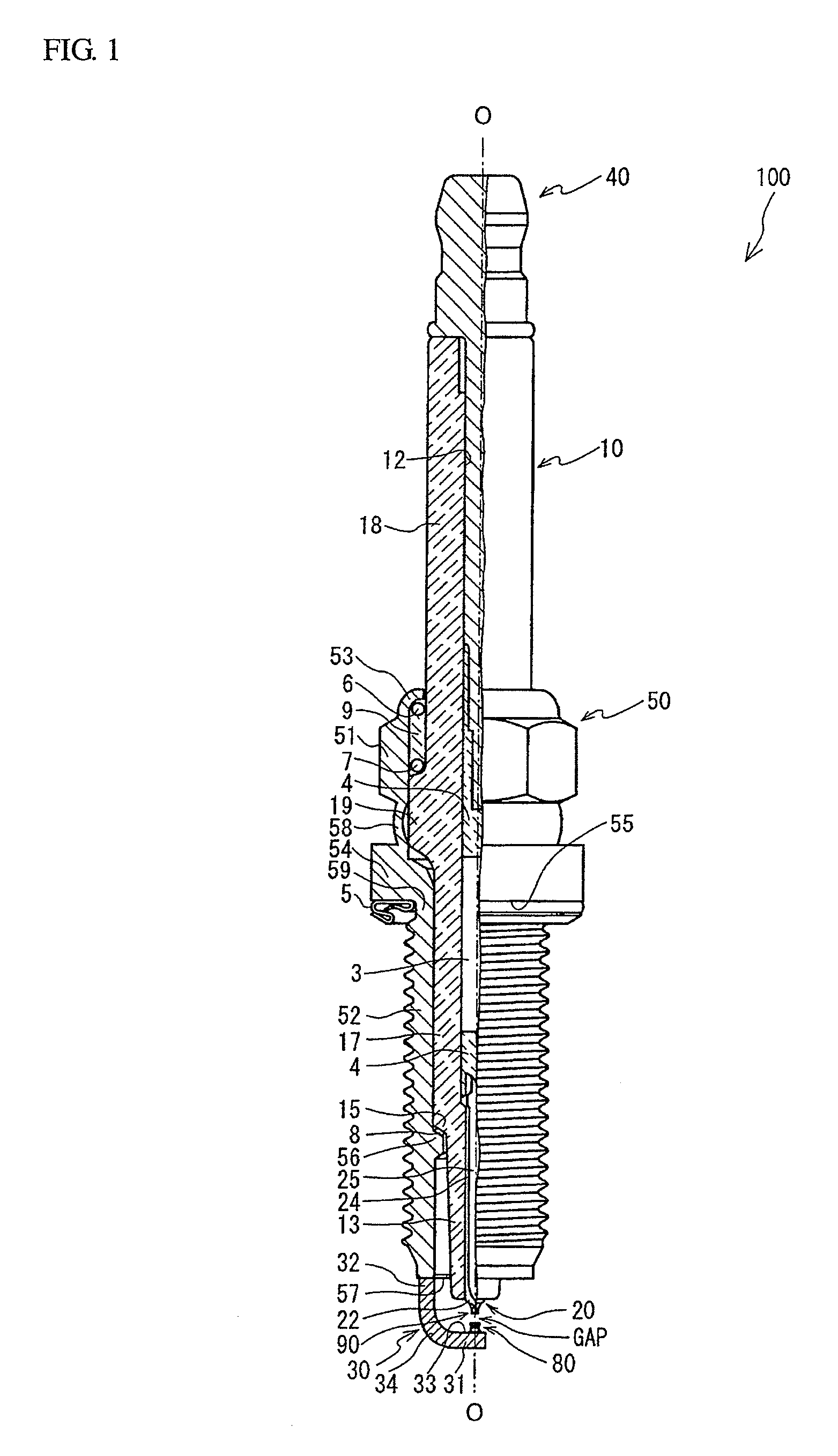Spark plug
a technology of spark plugs and noble metals, applied in spark plugs, basic electric elements, electric devices, etc., can solve the problems of increasing the amount of heat applied to the ground electrode of the spark plug, cracking or separation of the joint between the materials, and increasing the cross-sectional area of the heat radiation passage. , the ignition performance of the spark plug may deteriorate, and the noble metal member can be enhanced
- Summary
- Abstract
- Description
- Claims
- Application Information
AI Technical Summary
Benefits of technology
Problems solved by technology
Method used
Image
Examples
experiment 1
[0049]First, an evaluation test was conducted to verify the relationship between the ignition performance and the thermal conductivity of the intermediate member of the spark section. For this evaluation test, eight kinds of materials (N40, N35, N30, N25, N20, N15, N10 and N5) containing Ni as a main component and having different thermal conductivities were prepared for production of intermediate members. The compositions of the respective materials are indicated in TABLE 1.
TABLE 1Material ofComposition of intermediateThermalintermediatemember [wt %]conductivitymemberNiSiCrMnFeAlC[W / (m · K)]N40balance0.70.20.2—10.0240(97.88)N35balance1.20.20.2—2.20.0235(96.18)N30balance1.510.3—2.50.0230(94.68)N25balance1.51.52——0.0225(94.98)N20balance1.52230.50.0220(90.98)N15balance0.2160.38—0.0215(75.48)N10balance0.1250.1102.30.0210(62.48)N5 balance2302103.50.025(52.48)
[0050]As indicated in TABLE 1, the materials were prepared by mixing different contents of Si, Cr, Mn, Fe, Al and C (not using Fe ...
experiment 2
[0056]The same verification test was also conducted on the case of the noble metal member having a different thermal conductivity from that of Experiment 1. For this test, eight types of samples A21 to A28 of spark sections were produced by forming the same eight types of intermediate members as above from the above materials N40 to N5, forming noble metal members from Pt-10Ni (thermal conductivity: 27.8 W / (m·K)) and joining the noble metal members to the intermediate members, respectively. The sizes of the noble metal members and the intermediate members were the same as above. Further, a sample A29 (current product) of a spark section was formed as a reference for evaluation in the same manner as above using only a noble metal member of Pt-10Ni. The samples of A21 to A29 were attached to spark plugs for test uses. The same evaluation test procedure was conducted on each of the samples A21 to A29. The test results are indicated in TABLE 3.
TABLE 3Thermal conductivityMaterial of[W / (m...
experiment 3
[0059]Next, an evaluation test was conducted to verify the relationship between the spark wear resistance and the thermal conductivity of the intermediate member of the spark section. For this evaluation test, spark plugs having the same samples A21 to A29 as those of Experiment 2 were produced. Each of the spark plugs with the samples A21 to A29 was mounted on a 2.0-liter, 4-cylinder gasoline engine and tested by driving the engine under the conditions of 5000 rpm and WOT (full throttle) for 400 hours according to bench durability test procedure. The size of the spark gap GAP of each sample was measured after the durability test. Then, the difference between the initial size (1.1 mm) and the measured size of the spark gap GAP (i.e. the amount of consumption of the noble metal member by spark discharges) was determined. The test results are indicated in TABLE 4.
TABLE 4Thermal conductivityMaterial of[W / (m · K)]ConsumptionintermediateNoble metalIntermediateof noble metalSpark wearSamp...
PUM
 Login to View More
Login to View More Abstract
Description
Claims
Application Information
 Login to View More
Login to View More - R&D
- Intellectual Property
- Life Sciences
- Materials
- Tech Scout
- Unparalleled Data Quality
- Higher Quality Content
- 60% Fewer Hallucinations
Browse by: Latest US Patents, China's latest patents, Technical Efficacy Thesaurus, Application Domain, Technology Topic, Popular Technical Reports.
© 2025 PatSnap. All rights reserved.Legal|Privacy policy|Modern Slavery Act Transparency Statement|Sitemap|About US| Contact US: help@patsnap.com



